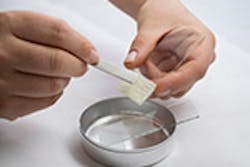Low CTE Adhesive for Optical Assembly
The optical community has long been vexed by the requirement to bond optical glass or mirrors to metal with adequate physical strength and dimensional stability, especially in systems with large mirror components. Such bonding applications require specific conditions which are difficult to achieve. They include: high bonding strength, ambient temperature cures, dimensional stability, precise alignment in the bond joint, minimal thermal expansion property, long term resistance to water, and other environments. Additionally the adhesive must be capable of withstanding stresses more broadly than do mechanical fasteners. Selection of an adhesive requires a balance of properties which will be specific to particular applications.
Perhaps the most difficult adhesive property relates to its thermal expansion coefficient. Most organic adhesives have significantly higher thermal expansion coefficient than either metal or glass, the properties of which are temperature dependent. High performance bonding of metals to glass demands adhesives with low thermal coefficients in order to minimize stress developments during and after bonding. Most commercially available adhesives do not meet this requirement. Master Bond polymer formulation number EP42HT-2LTE is a commercially available formulation with unmatched low thermal expansion coefficient of less than 10 x 10-6 inches per inch per °C suitable for service over the wide temperature range of 4k - +300°F. It is also noteworthy for its low linear (less than 0.01%) and volumetric (less than 0.1%) shrinkage. In addition, it passes the NASA low outgassing specifications, which might be vital in some sensitive optical devices.
Application Techniques for EP42HT-2LTE
EP42HT-2LTE has a forgiving, non-critical mix ratio of 100 to 50 by volume and after mixing the consistency is that of a paste with some flow. Two techniques can be employed to apply EP42HT-2LTE. For applications where items to be bonded are small, standard abrasion on the clean metal surface followed by application of pressure ensures an optimal bond. For applications where items to be bonded are significantly large, gluing fixtures are preferable to better control uniformity of the adhesive application and to maximize consistent optical performance. Preferred method of assembly should be determined on a case by case basis. Master Bond can help make this determination.
More on Certifications for Optical Assemblies
Other low outgassing epoxy adhesives have been developed to prevent contamination of sensitive electronic and optical components. These ASTM E595 compliant systems are NASA low outgassing approved for use in vacuum environments.
Select grades of adhesives have been tested for 1,000 hours at 85˚C/85% RH. These compounds have a high Tg, are employed for structural bonding, cure quickly and can withstand cryogenic shocks.
Please view the catalog “Adhesives, Sealants and Coatings for the Optical Industry” for more information on Master Bond high performance epoxies, silicones, UV/LED curing systems to meet the specialized requirements of the optical, fiber-optic, electro-optic, display, photonic and biophotonic industries.

